Ireland's mortality rate from cancer in 2022 was below the EU average, a new report from the European Union's Joint Research Centre (JRC) has found.
While the report estimated that 10,310 people died from cancer in Ireland in 2022, the mortality rate from cancer in Ireland in 2022 was below the EU average, with figures estimating that there were 260.1 deaths from cancer per 100,000 in Ireland in 2022, slightly below the EU average of 264.3.
Ireland's mortality rate from cancer was the 15th-highest among the 27 EU members in 2022, according to the report.
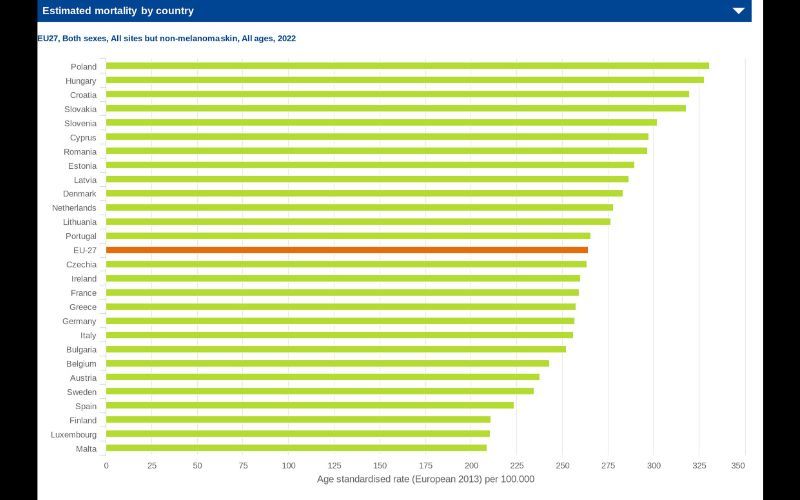
Estimated mortality by country. (ECIS - European Cancer Information System)
However, the report found that Irish females experienced the eighth-highest mortality rate in the EU in 2022 at 230.7 deaths per 100,000.
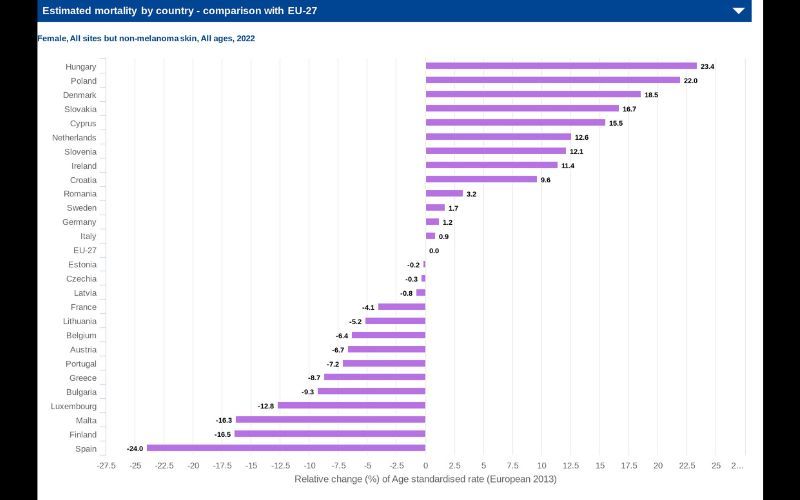
Female Estimated mortality by country - comparison with EU-27. (ECIS - European Cancer Information System)
On the other hand, Irish males experienced the fifth-lowest mortality rate in the EU last year at 297.5 deaths.
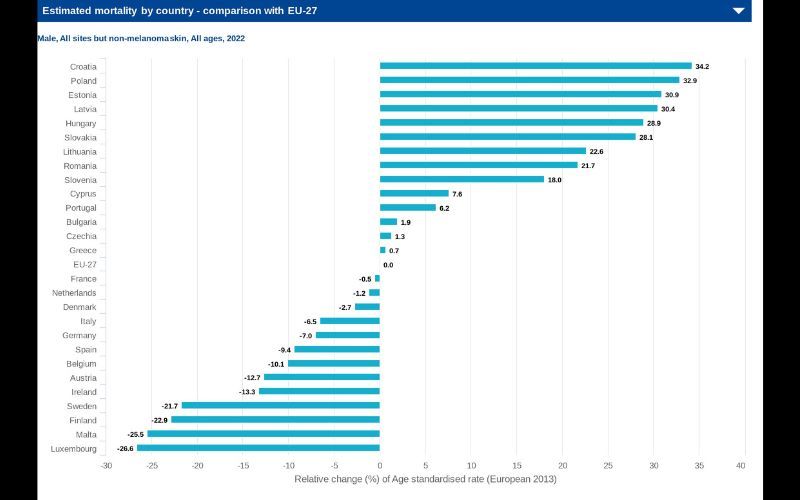
Male Estimated mortality by country - comparison with EU-27. (ECIS - European Cancer Information System)
Meanwhile, the new report also found that Ireland had the second-highest incidence of cancer per 100,000 of the population in the EU in 2022.
641.6 people out of every 100,000 in Ireland were affected by some form of cancer, excluding non-melanoma skin cancer, in 2022, the new European Commission report estimates.
It is the second-highest incidence of cancer among the 27 member states of the European Union after Denmark's rate of 728.5 per 100,000 people and just ahead of the Netherlands' rate of 641.4 per 100,000 people.
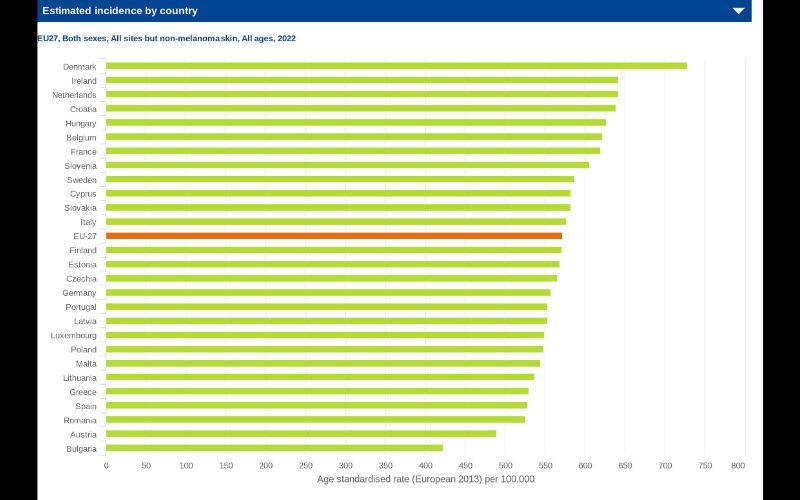
Estimated incidence by country. (ECIS - European Cancer Information System)
The report estimates that Ireland's cancer rate is 12.3% above the EU average, adding that an estimated 26,900 new cases of cancer were diagnosed in Ireland in 2022.
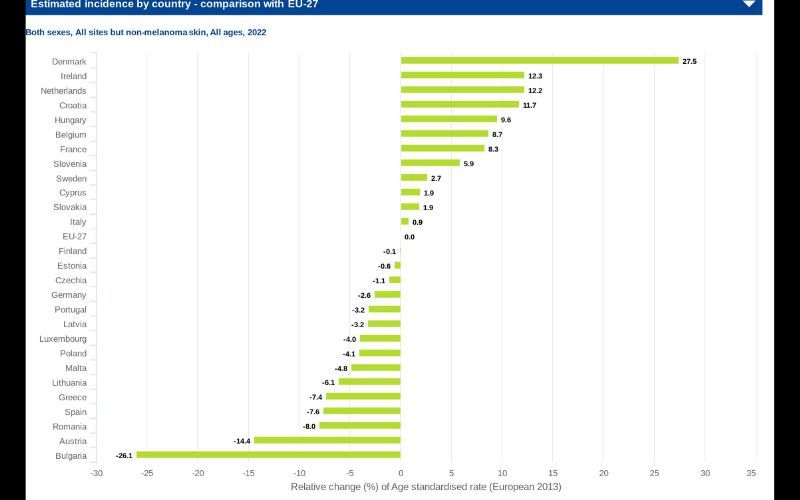
Estimated incidence by country EU27, Both sexes, All sites but non-melanoma skin, All ages, 2022 Age standardised rate (European 2013) per 100.000 422.4 - 483.6 483.6 - 544.8 544.8 - 606.1 606.1 - 667.3 667.3 - 728.5 Finland: 570.9 Estimated incidence by country - Comparison by sex EU27, Both sexes, All sites but non-melanoma skin, All ages, 2022 Age standardised rate (European 2013) per 100.000 532.9532.9 673.7673.7 684.8684.8 696.4696.4 756.7756.7 785.9785.9 659.3659.3 667.4667.4 732.7732.7 777.5777.5 779.8779.8 779.8779.8 810.7810.7 614.1614.1 640.3640.3 649.5649.5 662.2662.2 667.7667.7 677.2677.2 729.6729.6 801.7801.7 578.8578.8 624.9624.9 648.2648.2 709.9709.9 724.4724.4 739.8739.8 683.8683.8 356.4356.4 428.1428.1 484.3484.3 457.9457.9 468.9468.9 528.0528.0 511.2511.2 518.0518.0 561.3561.3 441.3441.3 452.2452.2 394.6394.6 665.2665.2 493.7493.7 538.0538.0 435.6435.6 422.2422.2 508.4508.4 460.1460.1 515.1515.1 529.4529.4 421.5421.5 501.0501.0 486.2486.2 589.4589.4 543.9543.9 524.1524.1 488.4488.4 Bulgaria Romania Czechia Poland Slovakia Hungary Finland Sweden Ireland Latvia Estonia Lithuania Denmark Malta Cyprus Greece Spain Italy Portugal Slovenia Croatia Austria Luxembourg Germany Netherlands Belgium France EU-27 Bulgaria Romania Czechia Poland Slovakia Hungary Finland Sweden Ireland Latvia Estonia Lithuania Denmark Malta Cyprus Greece Spain Italy Portugal Slovenia Croatia Austria Luxembourg Germany Netherlands Belgium France EU-27 900 800 700 600 500 400 300 200 100 0 100 200 300 400 500 600 700 800 900 Sex Male Female Estimated incidence by country - comparison with EU-27. (ECIS - European Cancer Information System)
Overall, new cancer cases in the EU rose by 2.3 % compared to 2020, to reach 2.74 million in 2022, the JRC said.
Similarly, cancer deaths went up by 2.4 % compared to 2020, according to the European Commission’s estimates published in the European Cancer Information System (ECIS).
Higher incidence rates are recorded in Western and Northern EU countries (more than 640 new cases per 100,000 people), while higher mortality rates are observed in Eastern EU countries (more than 300 deaths per 100,000 people).
According to the JRC, these geographical differences can be shaped by the prevalence of key risk factors for specific cancers; the effective delivery of national cancer control plans; the effective implementation of cancer screening programmes for breast, cervical and colorectal cancers; as well variations in diagnostic practice.
Meanwhile, the new 2022 estimates for EU Member States show that 31% of men and 25% of women are expected to be diagnosed with cancer before reaching the age of 75 years. 14% of men and 9% of women are estimated to die from cancer before reaching 75 years.
Cancer affects men slightly more than women in the EU: 53% of new cancer cases and 55% of cancer deaths occur in men.
Breast cancer remains the most diagnosed cancer in the EU, with an estimated 380,000 cases (99% of these affecting women) which constitutes some 13.8% of all cancer diagnoses. This is followed by colorectal (356,000; 13% of all new cases), prostate (330,000; 12.1%), and lung cancer (319,000; 11.6%).
The four most common cancer causes of death in the EU are estimated to be lung (19.5% of all cancer deaths), followed by colorectal (12.3%), breast (7.5%), and pancreatic cancer (7.4%).
The JRC noted that the European Commission recently presented a new approach to support Member States to increase their uptake in screening programmes. It aims to reach the target set in Europe's Beating Cancer Plan to offer breast, colorectal, and cervical cancer screenings to 90% of those who qualify by 2025. It should also be considered to extend screening should to include prostate, lung and gastric cancers, based on further research.
Preventing cancer being one of the four objectives of the EU Mission on Cancer, supporting research and innovation into better screening technologies, methodologies, and programmes is crucial to strengthen early detection.
The JRC's new cancer estimates show that these six cancer types account for 54.2% of all new cancer cases and 50.2% of cancer deaths in the EU in 2022.




Comments